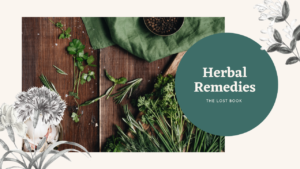Description
The Lost Book of Herbal Remedies
A Comprehensive Guide to Natural Healing
The Lost Book of Herbal Remedies by Nicole Apelian and Claude Davis is an extensive guide to the natural healing powers of herbs and plants. This valuable resource offers a deep dive into the world of herbal medicine, reconnecting readers with nature and the age-old wisdom of using plants for health and wellness. The book explores a wide range of remedies that have been used for centuries, providing detailed descriptions, images, and practical instructions on how to identify, harvest, and use various herbs for medicinal purposes.
Overview
The focus of The Lost Book of Herbal Remedies is on promoting natural healing through the use of plants, rather than relying solely on conventional pharmaceuticals. The book is structured to cater to a wide audience, from beginners looking to learn more about herbal remedies to those with more advanced knowledge of natural medicine. Its ultimate goal is to empower readers with the knowledge to heal naturally, sustain their well-being, and live in harmony with the environment.
Authors
The authors of this book bring a wealth of knowledge and expertise in the field of herbal medicine and survival skills.
- Nicole Apelian is a biologist, herbalist, and survival skills instructor. She has a deep passion for herbal medicine, supported by her educational background and years of practical experience. Apelian has used herbal remedies in her own life, notably to manage and combat the symptoms of multiple sclerosis, offering readers a personal and inspiring perspective on the power of plants.
- Claude Davis, a survival expert, complements Apelian’s expertise by offering a practical survivalist’s view of how herbs can be used in wilderness settings. Davis brings years of experience in self-sufficiency and survival techniques, offering insights into how these remedies can be utilized in emergency situations.
Together, Apelian and Davis provide a comprehensive and balanced approach to herbal medicine, with a focus on both health and survival.
Structure of the Book
The Lost Book of Herbal Remedies is organized into clear sections that guide readers through the process of understanding and using medicinal plants. Each section focuses on a specific category, from identifying common plants to preparing herbal remedies. Below are the key sections of the book:
Introduction to Herbal Remedies
The introductory section provides a foundational understanding of herbal medicine. It explains the benefits of using natural remedies over conventional pharmaceuticals, highlighting the often gentler yet effective nature of plant-based treatments. This section also includes essential safety guidelines for beginners, ensuring that readers understand the risks and precautions of using herbs.
Common Medicinal Plants and Trees
This section is one of the most comprehensive in the book, detailing a variety of easily identifiable plants and trees. Each plant profile includes a description of the plant, its medicinal properties, and how to properly use it for specific health concerns. The book provides not only the scientific aspects of these plants but also their historical uses, helping readers appreciate the deep cultural and medicinal significance of these plants. Additionally, there is guidance on how to sustainably harvest these plants, emphasizing ethical practices and environmental stewardship.
Edible Plants and Mushrooms
In this section, the authors explore a wide array of edible plants and mushrooms that have both nutritional and medicinal value. It provides recipes and practical methods for incorporating these plants into your daily diet. Not only do these plants contribute to good health by nourishing the body, but they also possess medicinal properties that can support overall wellness.
Remedies for Common Ailments
One of the most practical sections, this part of the book offers herbal remedies for a variety of everyday health issues, including colds, headaches, digestive problems, and skin conditions. The remedies are broken down into easy-to-follow, step-by-step instructions that outline how to prepare and use each treatment. The simplicity and accessibility of these remedies make it easy for readers to apply the knowledge in their own lives.
Herbal First Aid
A key feature of The Lost Book of Herbal Remedies is its focus on emergency situations and the use of plants for immediate relief. The Herbal First Aid section addresses common injuries, such as cuts, burns, and insect bites, and provides plant-based solutions for quick, effective treatment. This section is especially valuable for those interested in using herbs for self-sufficiency or in survival situations.
Advanced Herbal Medicine
For more experienced practitioners, this section delves into more complex health issues and their corresponding herbal treatments. It covers chronic conditions and explains how herbal medicine can support long-term health. Whether dealing with arthritis, diabetes, or other persistent ailments, this section provides valuable insights into the use of plants for ongoing wellness.
Highlights of the Book
- In-Depth Plant Profiles: Each plant included in the book is thoroughly researched and presented with detailed descriptions, clear photographs, and illustrations that help with identification.
- Historical Uses: The book provides an exploration of the historical significance of each plant, helping readers understand how these plants were utilized in traditional cultures for healing.
- DIY Remedies: The book includes practical instructions for preparing a wide variety of herbal preparations at home, including tinctures, salves, teas, and poultices.
- Survival Tips: Reflecting Davis’s expertise in survival, the book offers guidance on how these remedies can be applied in survival situations, providing practical survival tips for using herbs when living off the grid or in emergency situations.

Practical Applications
The practical focus of The Lost Book of Herbal Remedies is one of its key strengths.
- Home Medicine: The book encourages readers to create their own herbal medicine chest, offering clear guidance on how to grow, harvest, and store medicinal plants at home. This empowers individuals to take control of their health and reduce their reliance on pharmaceutical products.
- Sustainable Living: One of the core themes of the book is sustainable living. Apelian and Davis emphasize the importance of respecting nature by harvesting plants responsibly and in accordance with sustainable practices. This ensures that the natural resources used for healing will continue to thrive for generations to come.
- Empowerment: Ultimately, the book seeks to empower individuals to become self-reliant and independent by equipping them with the knowledge to heal naturally. It fosters a deeper connection to the earth and encourages readers to take responsibility for their own health and well-being.
Personal Experiences
A particularly compelling feature of The Lost Book of Herbal Remedies is the authors’ personal stories and experiences. Nicole Apelian’s journey with multiple sclerosis is a poignant example of how she used herbal remedies to manage her condition. Her story provides a real-life testament to the effectiveness of the natural remedies described in the book, making the information more relatable and inspiring for readers.
Conclusion
In conclusion, The Lost Book of Herbal Remedies is a valuable and comprehensive guide for anyone interested in natural healing, self-sufficiency, and sustainable living. It provides a wealth of knowledge on the medicinal properties of plants, with practical instructions on how to use them in everyday life. Whether you are a beginner or a seasoned herbalist, this book offers the tools and insights necessary to explore the healing power of plants, helping you live a healthier and more self-sufficient life. Through its rich content and thoughtful organization, The Lost Book of Herbal Remedies serves as an indispensable resource for anyone looking to reconnect with nature and harness the power of herbal medicine.






Reviews
There are no reviews yet.